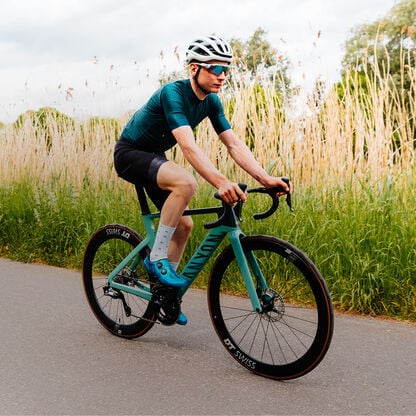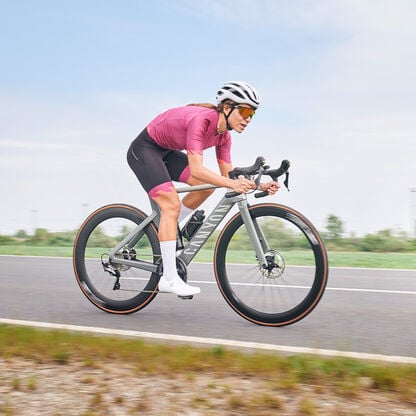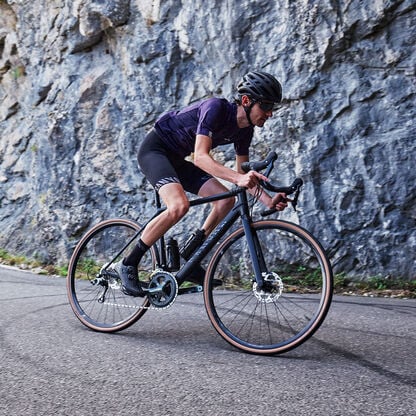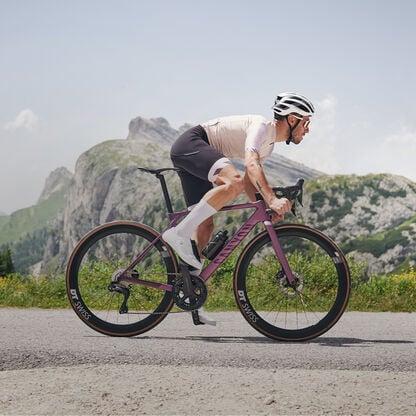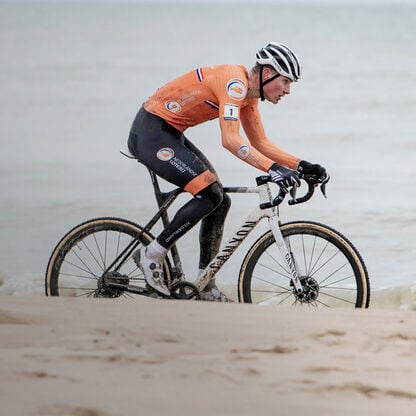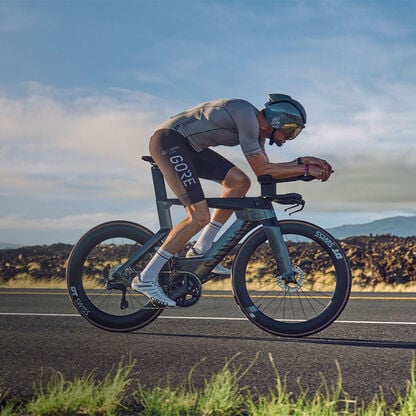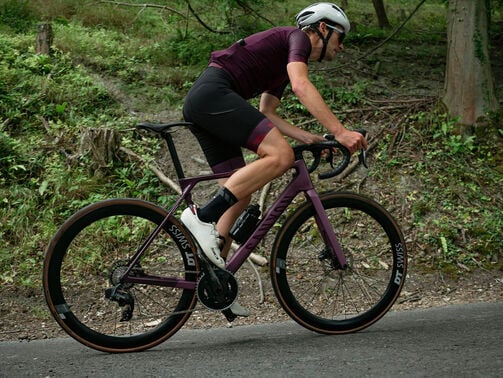Our tips for crossing the Alps on your road bike
Cycling across the Alps is the main event of a good year for many road cyclists – and a long-held aspiration for others.

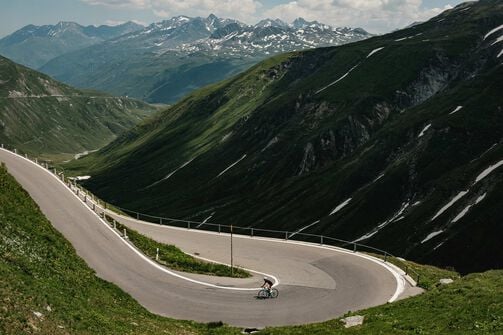
Climbing mountain passes on your own power, finding your rhythm on the hairpin descents, savouring the euphoria at the summit and enjoying the breath-taking vista, and pedalling until your mind is completely at peace: cycling across the alps is an unforgettable experience. We have some tips for your big adventure – from picking the right bike to planning your transalpine route.
Why even ride across the Alps on a road bike?
Crossing the Alps on a road bike can be a truly extreme challenge. Euphoria and exhaustion, fun and pain, joy and suffering are never far apart. Taking on the highest roads of Europe by muscle power: most people who haven’t experienced the fascination of cycling would probably consider this idea a sign of insanity.
But for road cyclists, it is unquestionably a badge of honour, and many of us dream about doing it for years. Finally taking on this physical and mental challenge after long months of training and preparation is a truly unique feeling. With route planning, spectacular photos, and the nagging uncertainty about whether you will actually succeed, crossing the Alps on your road bike is an emotional roller coaster.
Which transalpine route is at the top of your cycling bucket list?
There are many routes across the Alps. Most classic transalpine routes start somewhere south of Munich in Germany, in Garmisch-Partenkirchen or Kempten.
One popular route goes from Garmisch via the Seefeld region to Tyrol. Here, highlights include the Möserer Berg, the picturesque Pillerhöhe, Norbertshöhe, Nauders and finally the Reschen Pass on the Italian border with the famous church steeple rising from a water reservoir. After passing through Prad, you’ll be on your way to the Stelvio Pass. One of the most famous Alpine climbs, the legendary Stelvio Pass is often considered the crown jewel of any Alpine crossing by bike.
Here, you are faced with a difficult choice: bomb down the descent to the popular skiing town of Bormio and continue onto Gavia Pass – or take a detour via Switzerland? In the latter case, your route takes you through Val Müstair to the Fuorn Pass and on to Bormio via the Eira and Foscagno Passes. From Bormio, you can head up the Mortirolo Pass.
The Mortirolo Pass is legendary. Locals lovingly call the mountain road, which is one of the steepest and toughest climbs in the entire Alps, the wall. Its average gradient above Tovo di Sant’Agata is more than twelve percent.
The picturesque Gavia Pass is another truly epic climb. Its southern leg features several ramps at 14 or even 16 percent. Riders are rewarded by some of the most beautiful landscapes along any Alpine pass, especially around Lago Nero just south of its highest point.
After the Mortirolo Pass, continue along the Passo Tonale to the beautiful village of Madonna di Campiglio in the Trentino region. The last stage combines the Daone and Durone Passes with Passo Ballino – the last Alpine pass on this route. Then, you’ve finally made it: once you arrive in Torbole near Riva on Lago di Garda, you have officially crossed the Alps on your road bike.
Whether you pick the “easy” route via Reschen Pass, the Dolomites, the Stelvio Pass, or the shortest path via Timmelsjoch: there is a broad range of different transalpine routes for first-timers and veteran climbers alike.
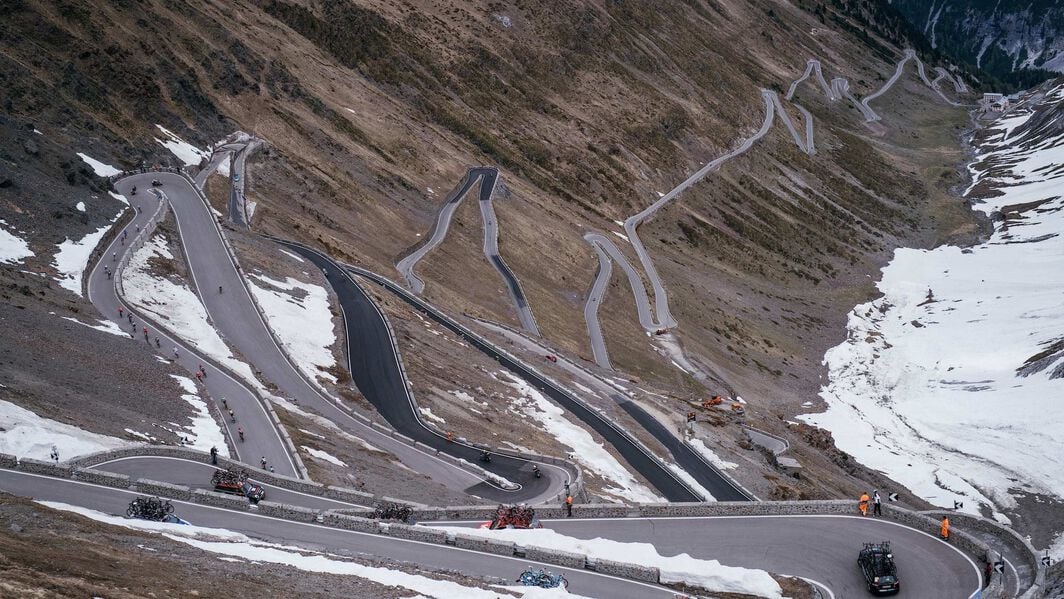
Crossing the Alps on a road bike: Things you need to know
Let’s talk about preparing for your Alpine crossing, so that your dream of riding the Stelvio Pass and other epic mountain roads on your transalpine route doesn’t turn into a nightmare.
Saving weight is key when it comes to packing. Only take what you really need – but not at the expense of your safety and well-being. There are some excellent ultra-light backpacks around 30 litres in volume that can hold up to a week’s worth of essentials. Keep in mind you will be spending a lot of time in the saddle.
Oh, but there is! On a summer morning with clear skies and little traffic, the route from Prad to Bormio is every well-prepared cyclist’s dream. But add fog, rain, or even snow to the mix, and the Alpine route leading all the way up to 2,757 metres above sea level can become truly horrific. In the Alps, you should always carry a wind stopper as well as arm and leg warmers for the descents.
The route to Bormio takes you through a number of rock sheds. You should definitely take some lights to make sure you stay visible. It’s also best to avoid the highest mountain pass of Italy during the busiest afternoon hours on a warm summer weekend – the motorised traffic with motorcycles, cars, and coaches can be brutal. You’re better off starting early in the morning on a weekday. That way, you can really enjoy the breath-taking mountain views.
You should make sure you get a good amount of climbing under your belt early on in the season before you tackle Alpine passes like the legendary Stelvio. After all, things are different at 2,000 m above sea level!
If you intend to hit several of the most epic passes on your Alpine crossing, you should take the cumulative effort of several days’ worth of climbing into account. When you arrive in Bormio after two long and hard days in the saddle, a rest day is probably a good idea. Only the toughest riders who train for extreme elevation gains can expect to manage a third day of riding like that – especially if the route features monumental climbs like the Mortirolo or Gavia Passes.
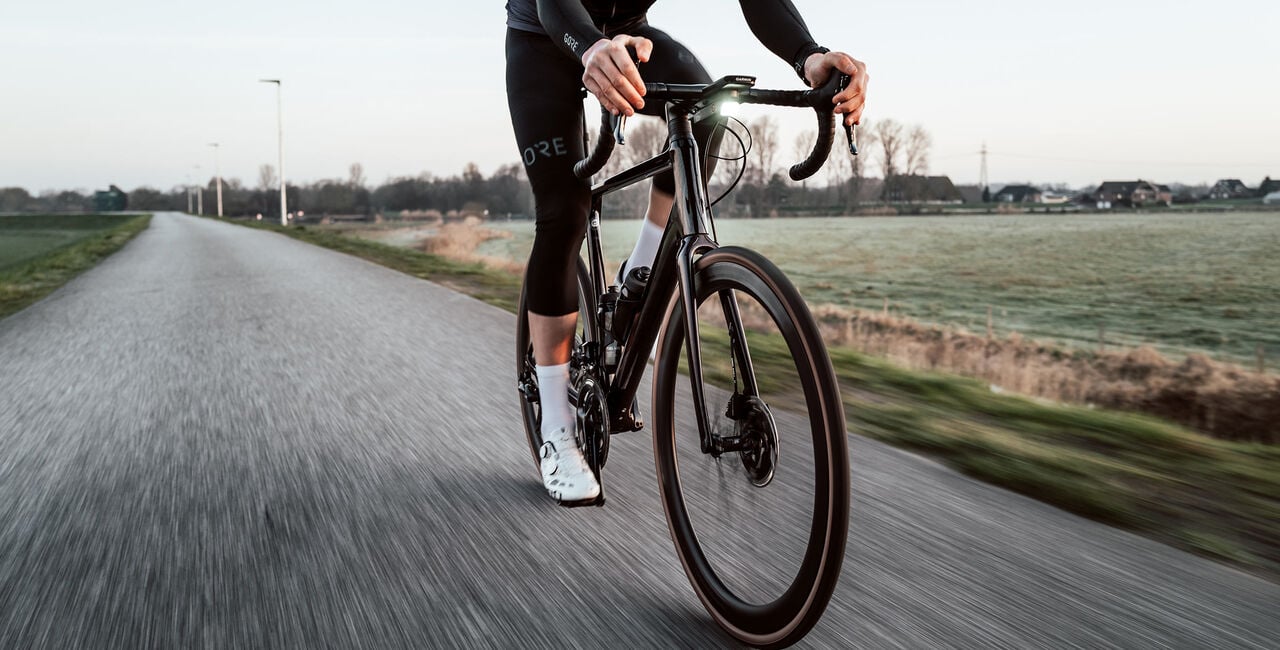
Canyon cycling gear
Which road bike is best suited for the Alps?
Long-range comfort, versatility, and speed: Endurance road bikes are probably the best choice for cyclists who want to cross the Alps at an athletic pace and with a good amount of comfort. Transalpine cycling calls for a well-rounded bike that can handle a lot of different situations. With an endurance road bike, you will be able to stay in the saddle longer and make the most of your Alpine crossing without sacrificing much speed at all.
From entry-level models with alloy frames all the way to high-end endurance race bikes, there’s a good choice for every budget. And if you want to make absolutely sure you get there, consider riding opting for electronic support with smart battery management, comfortable endurance geometry and classic road bike handling.
Even pros know the value of being comfortable on your bike. It is a well-established fact that a comfortable bike helps prevent premature exhaustion. Even after hours in the saddle of a good endurance bike, you can still put down some serious power. The three components that make and break a comfortable road bike are the frame, tyres, and seat post.
Carbon fibre technology has advanced so far that we can now build bikes that would have been impossible a few years ago. Their frames can be extremely stiff and efficient while offering just the right amount of vertical flex in the fork and rear triangle. This compliance lets the frame absorb the constant vibrations from the ground. In combination with a carbon seat post, this effect can be maximised. That way, riding the bike continues to be enjoyable even after several days with hours and hours of climbing in the Alps.
Many modern endurance road bikes feature disc brakes. This eliminates the rim brake callipers, which limit tyre width, so that only the frame and fork clearance dictate the maximum tyre width for a bike. As a result, many endurance road bikes come with wider tyres that are run at lower pressure for low rolling resistance, improved comfort and excellent grip and therefore safety.
Today, 28 mm tyres are actually on the narrow end in the endurance category. Most bikes of this type come with 30 mm or even 32 mm rubber. And the best part: this makes an endurance road bike even more versatile. Short gravel sections – not unheard of on a transalpine adventure – are well within the capabilities of these models.
Endurance road bikes
Bikes developed for bikepacking, gravel riding or winning the Transcontinental Race
Discover all modelsCan I cross the Alps on my road bike as a beginner?
The good news: even moderately fit cyclists can ride across the Alps. If you ride at least 50 kilometres with around 600 meters of elevation twice a week on a regular basis, that’s a great place to start. To get a better sense of what a day riding in the Alps will be like, you should also try going on rides with upwards of 1,000 meters of elevation every now and then.
Once you’re ready to take on the Alps, planning your stages is crucial. You need to be able to focus on riding your own pace on every single stage. You should also make sure you stay on top of your nutrition with plenty of carbohydrates and isotonic drinks.
“The human body can only process 60 to 90 grams of carbohydrate intake per hour, but it can burn up to 200 grams’ worth of energy. As a rule of thumb, many riders eat one bar per hour per 25 kg of body weight. For a rider weighing 75 kg, that means eating three bars per hour. Depending on the heat, you should also drink between 0.75 and 1 litre of isotonic fluids per hour.”
As a beginner, you should include at least one rest day in your transalpine itinerary. Your rest day should come after the second or perhaps third day of riding. A rest day is an important chance for your body to recover.
Cycling across the Alps – on your own or in a group?
If you take your road bike across the Alps by yourself, the main benefit is that you can always set your own pace and make each stage as long or short as you like. But there is also a downside: most riders end up spending too much time in the saddle when left to their own devices. A group can help you get through difficult stretches, provide the occasional draft so you can recharge, and improve your overall safety. You don’t get these benefits if you ride by yourself. However, you are almost guaranteed to meet other cyclists in the Alps with whom you can team up for a while.
For most of us, riding in a gruppetto is twice the fun. If you want to cycle across the Alps with your friends, you should make sure you communicate well about your fitness levels. You should know in advance whether you’ll be able to keep up a similar pace for several days. The main characteristics of a good group are team spirit and solidarity. Riding across the Alps with friends is not the time for competition. Overeager riders can learn a lot from bringing up the rear for a while and taking good care of their weaker companions.
Do you need a guide for riding your road bike across the Alps?
A guided tour with pre-arranged accommodation and a fresh change of clothes waiting at the end of every stage is certainly the most worry-free way to go. That is why some riders like to book a guided Alpine crossing from reputable companies.
A good guide makes sure that even a larger group of 16 riders finds the tour equally enjoyable. It’s all about making sure that the fastest riders can have fun without making the slowest riders feel unsafe. This typically means separating on steep mountains and keeping the group together on the flats. Those with power to spare can always provide a nice draft for their weaker companions.
Your guide and driver should also be familiar with the area and make sure that the van is always in a good position. That way, they can pick up riders who couldn’t make a climb or offer a change of clothes before the big descents. Experienced guides also have a good sense of the right balance between breaks and riding time.
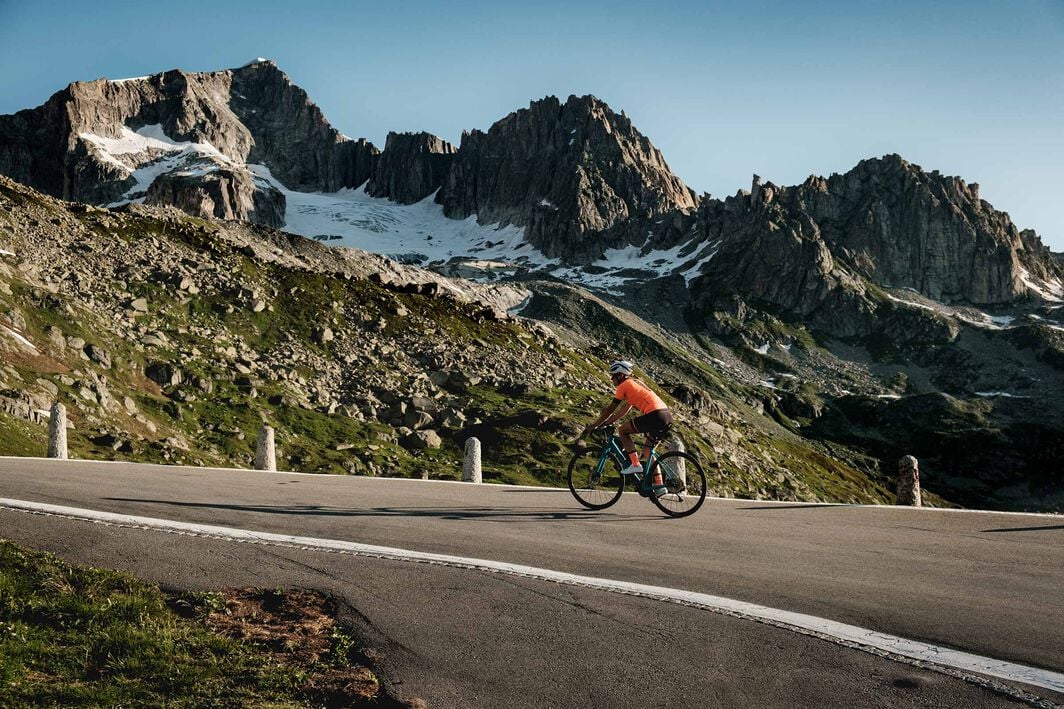
Where can I find routes for crossing the Alps on a road bike?
The websites of cycling magazines and many outdoor apps provide a selection of routes for crossing the Alps on a road bike. These are typically available as a GPX download as well as other commonly used formats. That way, you can simply download them to your cycling computer and start navigating whenever you’re ready to go. And there are routes for all riders: from beginners to certifiable mountain goats, everyone should be able to find a good option.
Discover our Road Bikes
Did this article help?
Thank you for your feedback
